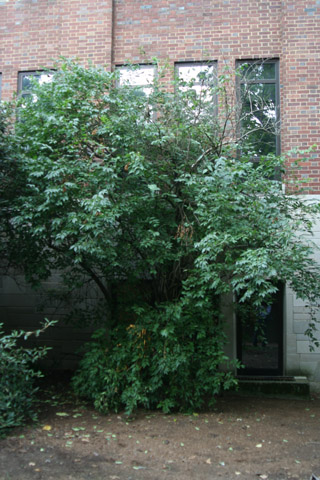
Permanent unique identifier for this particular organism:
http://bioimages.vanderbilt.edu/ind-baskauf/91069
Notes:
This shrub or small tree grows against the east side of Garland Hall.
Everyone in middle Tennessee who cares about the natural environment should learn to identify bush honeysuckle. It is an incredibly invasive tree species and as such is one of the greatest threats to natural areas in the vicinity.
Bush honeysuckle leaves taper to a point and are opposite on the twig. In the spring they have strong-smelling white flowers. Later in the summer, they produce large numbers of red berries that are eaten and spread by birds. One can recognize the stems or trunks by the bark, which has characteristic vertical "claw marks". The stems arc outward from the clump, another characteristic that make the species recognizable from a distance.
Fortunately, bush honeysuckle is still relative rare outside the metropolitan Nashville area. But within Nashville, it is everywhere, choking out the native vegetation even in relatively undisturbed natural areas such as Radnor Lake and Warner Parks. This species should never be planted and should be removed wherever possible. Unfortunately, it is difficult to dig up large trees and unless all of the roots are removed, the bush will resprout.
Everyone in middle Tennessee who cares about the natural environment should learn to identify bush honeysuckle. It is an incredibly invasive tree species and as such is one of the greatest threats to natural areas in the vicinity.
Bush honeysuckle leaves taper to a point and are opposite on the twig. In the spring they have strong-smelling white flowers. Later in the summer, they produce large numbers of red berries that are eaten and spread by birds. One can recognize the stems or trunks by the bark, which has characteristic vertical "claw marks". The stems arc outward from the clump, another characteristic that make the species recognizable from a distance.
Fortunately, bush honeysuckle is still relative rare outside the metropolitan Nashville area. But within Nashville, it is everywhere, choking out the native vegetation even in relatively undisturbed natural areas such as Radnor Lake and Warner Parks. This species should never be planted and should be removed wherever possible. Unfortunately, it is difficult to dig up large trees and unless all of the roots are removed, the bush will resprout.
 |  |
Load database and switch to thumbnail view
Use this stable URL to link to this page:
http://bioimages.vanderbilt.edu/ind-baskauf/91069.htm
This organism is a living specimen that is part of the Vanderbilt University Arboretum with the local identifier unnumbered1.
This particular organism is believed to have managedmeans of establishment.
This organismal entity has the scope: multicellular organism.
Identifications:
Lonicera maackii
(Rupr.) Herder
sec. Gleason Cronquist 1991
common name: Amur honeysuckle
family: Caprifoliaceae
Identified 2014-09-11 by Steven J. Baskauf
Location:
east of Garland Hall, Vanderbilt University, Nashville, Davidson County, Tennessee, US
Click on these geocoordinates to load a map showing the location: 36.14648°, -86.80148°
Coordinate uncertainty about: 10 m.
Location determined from Google maps.
Occurrences were recorded for this particular organism on the following dates:
2014-09-11
The following images document this particular organism.
Click on a thumbnail to view the image and its metadata.Load database and enable navigation by taxon and organism.
| Image | View |
 | whole tree (or vine) - general |